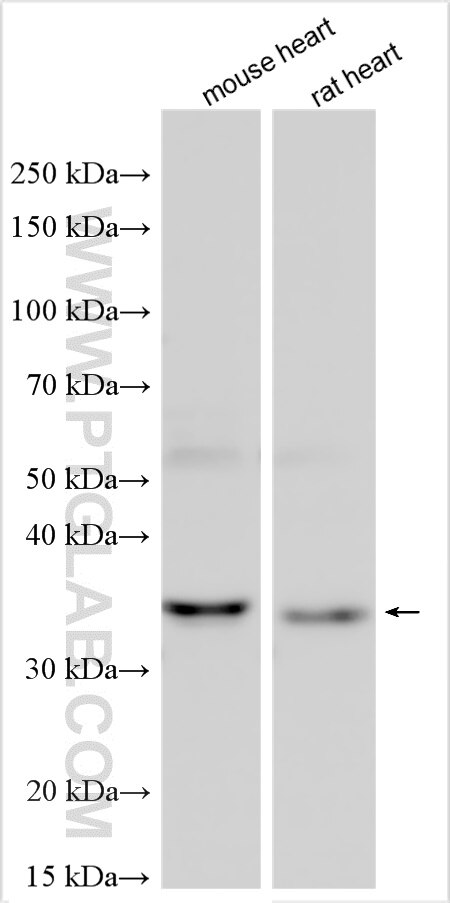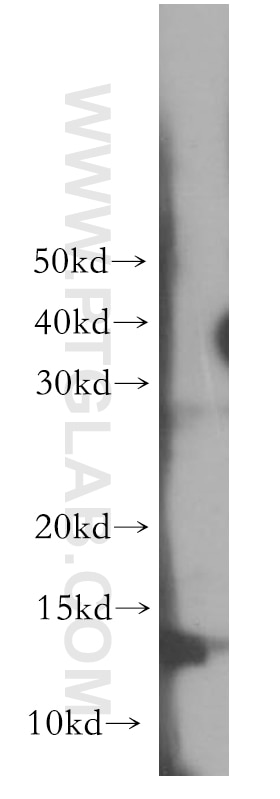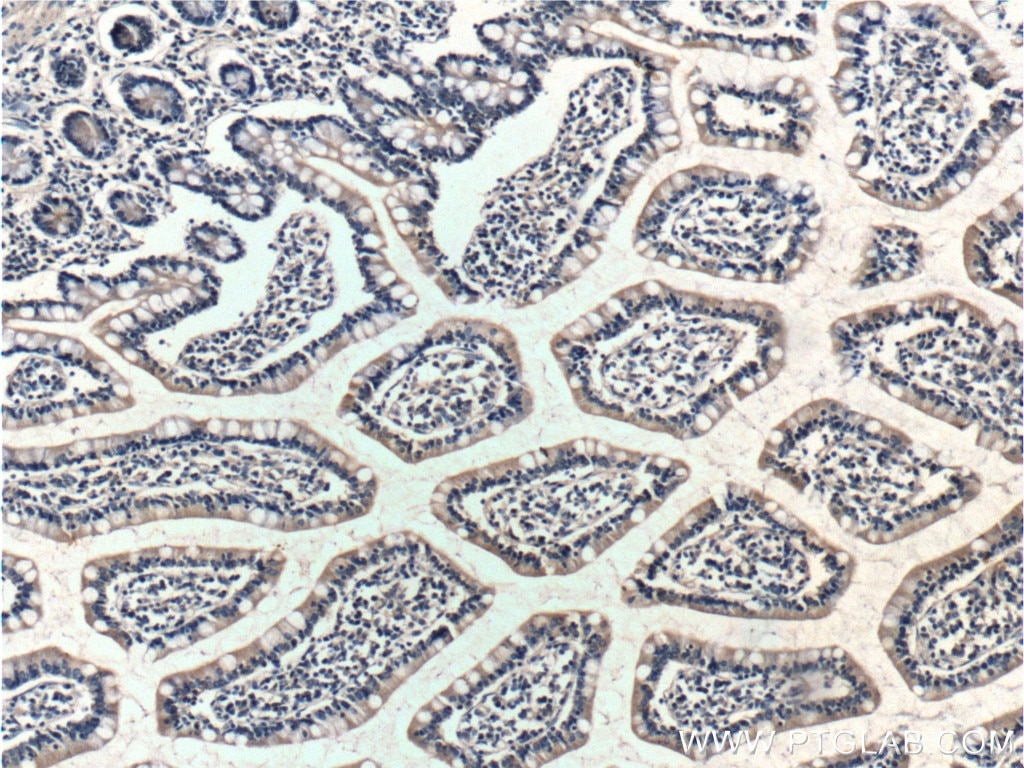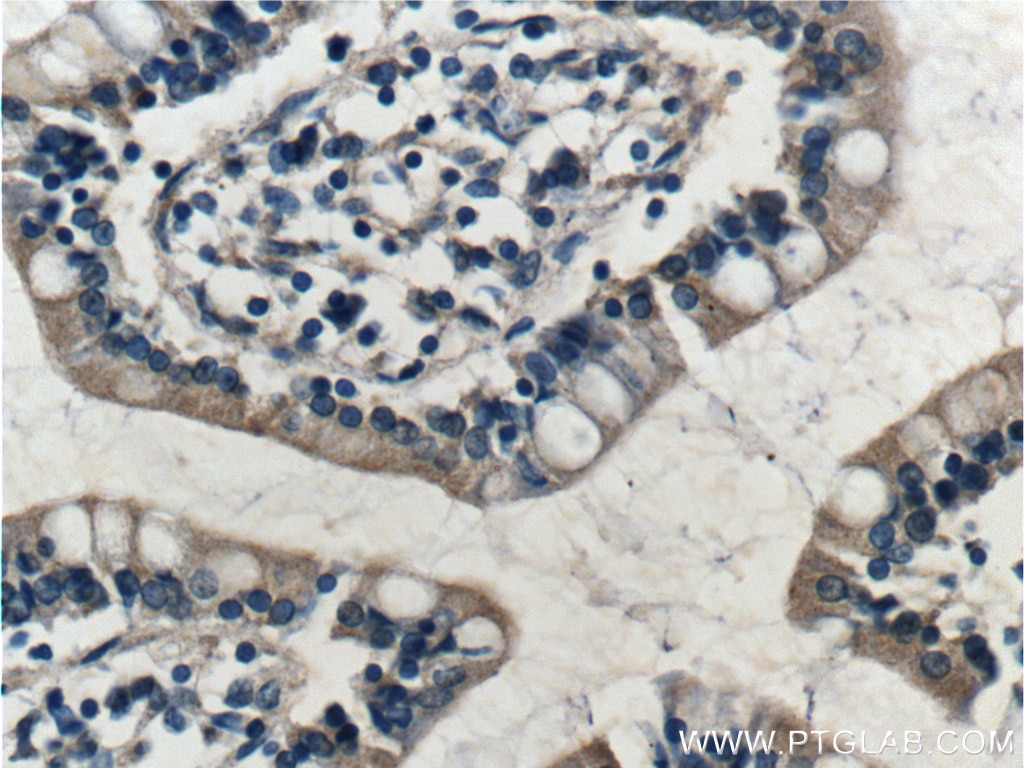Anticorps Polyclonal de lapin anti-RAMP1
RAMP1 Polyclonal Antibody for WB, IHC, ELISA
Hôte / Isotype
Lapin / IgG
Réactivité testée
Humain, rat, souris
Applications
WB, IF, IHC, ELISA
Conjugaison
Non conjugué
N° de cat : 10327-1-AP
Synonymes
Galerie de données de validation
Applications testées
| Résultats positifs en WB | tissu cardiaque de souris, tissu cardiaque de rat, tissu cardiaque humain |
| Résultats positifs en IHC | tissu d'intestin grêle humain il est suggéré de démasquer l'antigène avec un tampon de TE buffer pH 9.0; (*) À défaut, 'le démasquage de l'antigène peut être 'effectué avec un tampon citrate pH 6,0. |
Dilution recommandée
| Application | Dilution |
|---|---|
| Western Blot (WB) | WB : 1:500-1:3000 |
| Immunohistochimie (IHC) | IHC : 1:50-1:500 |
| It is recommended that this reagent should be titrated in each testing system to obtain optimal results. | |
| Sample-dependent, check data in validation data gallery | |
Applications publiées
| WB | See 1 publications below |
| IHC | See 1 publications below |
| IF | See 2 publications below |
Informations sur le produit
10327-1-AP cible RAMP1 dans les applications de WB, IF, IHC, ELISA et montre une réactivité avec des échantillons Humain, rat, souris
| Réactivité | Humain, rat, souris |
| Réactivité citée | rat |
| Hôte / Isotype | Lapin / IgG |
| Clonalité | Polyclonal |
| Type | Anticorps |
| Immunogène | RAMP1 Protéine recombinante Ag0402 |
| Nom complet | receptor (G protein-coupled) activity modifying protein 1 |
| Masse moléculaire calculée | 17 kDa |
| Poids moléculaire observé | 14 kDa, 35 kDa |
| Numéro d’acquisition GenBank | BC000548 |
| Symbole du gène | RAMP1 |
| Identification du gène (NCBI) | 10267 |
| Conjugaison | Non conjugué |
| Forme | Liquide |
| Méthode de purification | Purification par affinité contre l'antigène |
| Tampon de stockage | PBS avec azoture de sodium à 0,02 % et glycérol à 50 % pH 7,3 |
| Conditions de stockage | Stocker à -20°C. Stable pendant un an après l'expédition. L'aliquotage n'est pas nécessaire pour le stockage à -20oC Les 20ul contiennent 0,1% de BSA. |
Informations générales
RAMP1 (receptor-activity-modifying protein) is a member of the RAMP family of single-transmembrane-domain proteins which consist of an N-terminal extracellular domain, a transmembrane region, and a short intracellular C-terminal tail. RAMPs are required to transport calcitonin-receptor-like receptor (CRLR) to the plasma membrane. CRLR, a G protein-coupled receptor, can function as either a calcitonin gene-related peptide (CGRP) receptor or an adrenomedullin receptor, depending on which members of the RAMP family are expressed. RAMP1 transports the CRLR to the plasma membrane and then remains associated with it to function as a terminally glycosylated CGRP receptor, while RAMP2 and RAMP3 transfer the CRLR to the cell surface to generate receptors that are preferentially selective for adrenomedullin. RAMP1 can form a homodimer which migrates at 30-37 kDa on SDS-PAGE. (PMID: 9620797; 16188935; 12051717;PMID: 18384073)
Protocole
| Product Specific Protocols | |
|---|---|
| WB protocol for RAMP1 antibody 10327-1-AP | Download protocol |
| IHC protocol for RAMP1 antibody 10327-1-AP | Download protocol |
| FC protocol for RAMP1 antibody 10327-1-AP | Download protocol |
| Standard Protocols | |
|---|---|
| Click here to view our Standard Protocols |
Publications
| Species | Application | Title |
|---|---|---|
J Headache Pain Calcitonin gene-related peptide receptor antagonist BIBN4096BS regulates synaptic transmission in the vestibular nucleus and improves vestibular function via PKC/ERK/CREB pathway in an experimental chronic migraine rat model. | ||
Front Pharmacol Effect of Xiongmatang Extract on Behavioral and TRPV1-CGRP/CGRP-R Pathway in Rats With Migraine. | ||
Neurosci Lett Calcitonin gene-related peptide differentially regulates gene and protein expression in trigeminal glia cells: findings from array analysis. |





